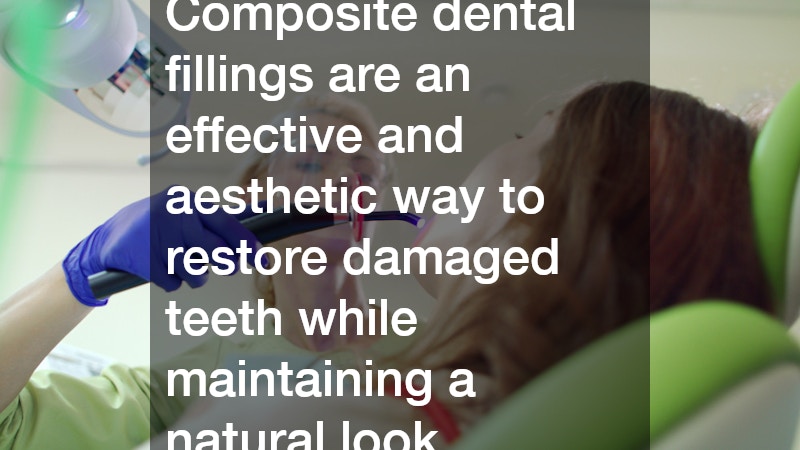What to Expect After Getting a Composite Dental Filling
Composite dental fillings are a popular choice for repairing cavities because they blend naturally with your teeth while providing lasting protection. However, it’s common for patients to have questions about what happens after the procedure. From short-term sensitivity to long-term maintenance, understanding the recovery process can help ensure your filling lasts for years. This guide explains what to expect after getting a composite dental filling and how to care for your restored tooth properly.
How Long Will the Sensitivity Last?
Understanding Initial Discomfort
It’s normal to experience mild discomfort or sensitivity immediately after your filling. This occurs because your tooth and surrounding tissues need time to adjust after decay removal and the placement of new material.
Most patients notice that any soreness or temperature sensitivity begins to fade within a few days.
Types of Sensitivity
Common types of post-filling sensitivity include temperature sensitivity (to hot or cold foods), pressure sensitivity when biting down, and minor soreness in the gums. These reactions are typically temporary and vary based on the filling’s size, depth, and location.
Managing Sensitivity at Home
You can manage discomfort at home by avoiding extreme temperatures in food and drinks for the first few days, using a soft-bristled toothbrush, and taking over-the-counter pain relief if necessary. Desensitizing toothpaste can also help calm sensitive nerves around the treated tooth.
When to Contact Your Dentist
If pain or sensitivity worsens after several days, or if you experience sharp, persistent discomfort when biting, contact your dentist. The filling may need a minor adjustment to your bite alignment. Early evaluation can prevent long-term complications or additional discomfort.
Long-term Expectations
In most cases, sensitivity subsides completely within two weeks. Once your tooth fully adapts to the new filling, it should feel and function like a natural tooth, with no lingering discomfort.
What Precautions Should Be Taken Immediately After Filling?
Avoiding Certain Foods and Drinks
Composite fillings harden almost instantly under curing light, but your tooth may remain sensitive for a short time. Avoid sticky, hard, or extremely hot and cold foods immediately after treatment. These can irritate the area or dislodge a freshly placed filling.
Proper Oral Hygiene Practices
Continue brushing and flossing gently around the filled tooth. Maintaining proper oral hygiene prevents bacteria from entering around the edges of the filling, which could lead to future decay. Always use a soft toothbrush and non-abrasive toothpaste to protect the surface.
Advice on Eating and Drinking
Wait until any numbness from anesthesia has fully worn off before eating. Biting or chewing while numb can accidentally injure your tongue or cheeks. Once sensation returns, eat soft foods at first and gradually reintroduce firmer textures as comfort improves.
Use of Dental Guards or Protection
If you grind or clench your teeth at night, a custom dental guard can protect your new filling and prevent wear. Grinding places stress on composite material and can shorten its lifespan.
Are There Any Potential Complications?
Signs of Filling Failure
Over time, fillings may wear down or loosen. Common signs of failure include sharp pain, visible cracks, or food getting stuck around the edges of the filling. Prompt evaluation and repair prevent further damage to the tooth.
Handling Cracks or Damage
If you notice a chip or crack in your filling, avoid chewing on that side of your mouth and call your dentist as soon as possible. Early repair is usually quick and painless, preserving both the filling and the tooth structure.
How Do Composite Fillings Compare to Other Types?
Aesthetic Differences
Composite fillings closely match the color of natural teeth, making them ideal for visible areas. In contrast, silver amalgam fillings have a metallic appearance and can darken over time.
Durability and Longevity
While amalgam fillings may last slightly longer on average, modern composite materials are highly durable and capable of withstanding normal chewing forces for many years. With proper care, composite fillings typically last 7 to 10 years or more.
Environmental Considerations
Composite fillings are mercury-free and more environmentally friendly than amalgam fillings, which contain trace metals. This makes them a preferred choice for patients who prioritize biocompatibility and sustainability.
How Should Composite Fillings Be Maintained?
Routine Dental Check-ups
Regular dental exams and cleanings help ensure your fillings remain in excellent condition. Your dentist will inspect for early signs of wear or separation, which can be corrected before becoming serious problems.
Tips for Prolonging Filling Life
Avoid chewing on hard objects like ice or pens, and limit sticky or sugary snacks. Practicing consistent oral hygiene and scheduling professional cleanings every six months will help extend the life of your composite filling and maintain your overall oral health.
Composite dental fillings are an effective and aesthetic way to restore damaged teeth while maintaining a natural look. Mild sensitivity and short-term precautions are normal parts of recovery, but most patients adjust quickly and enjoy years of comfortable function. By following your dentist’s care instructions and maintaining good oral hygiene, you can protect your new filling and preserve your smile with confidence.

